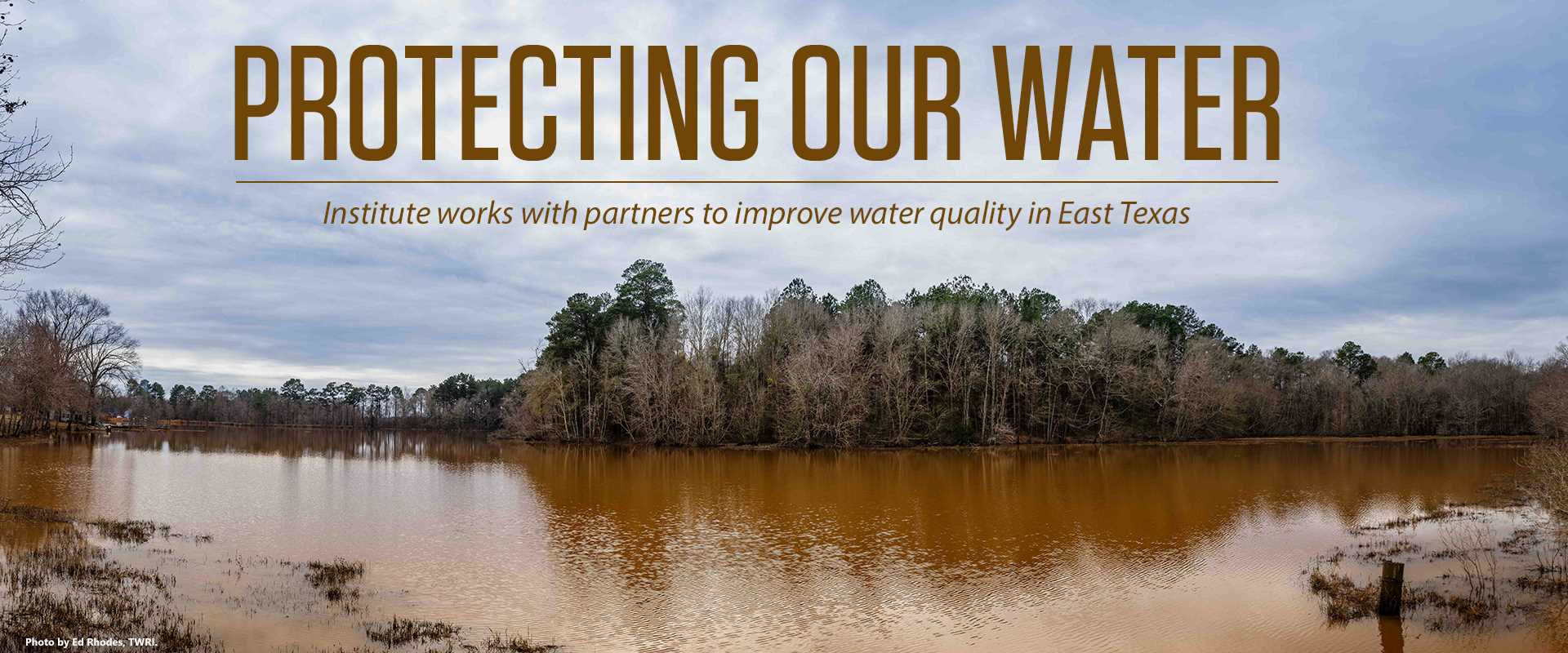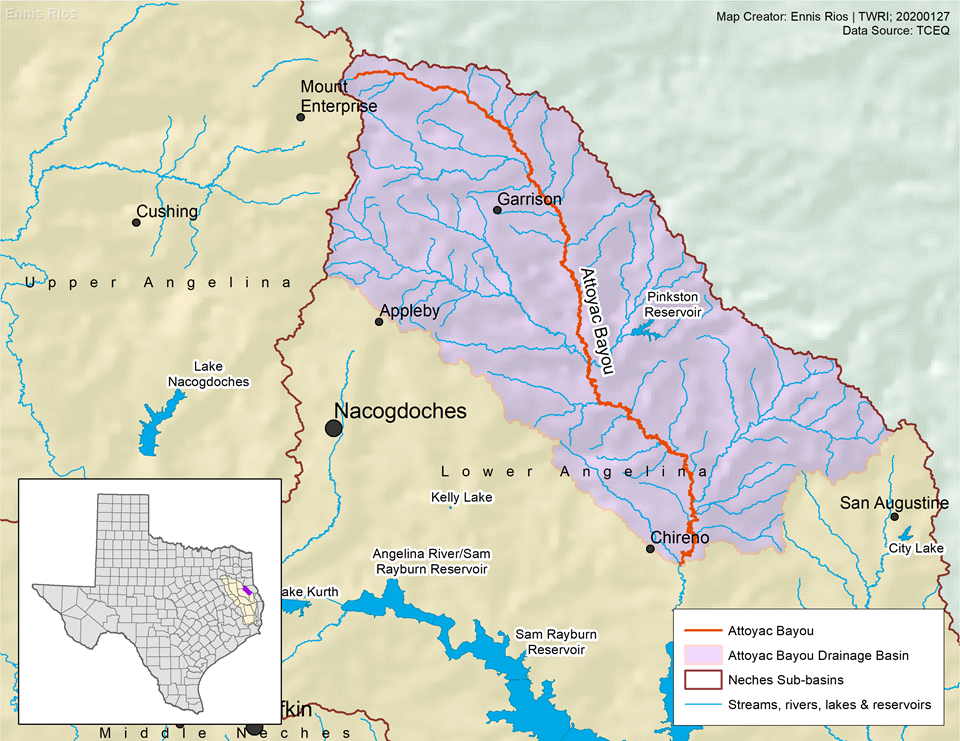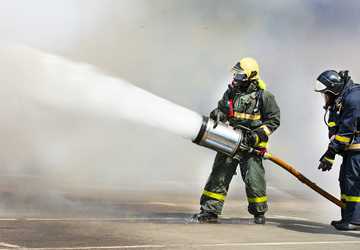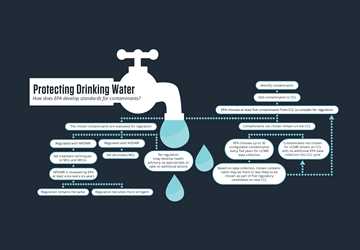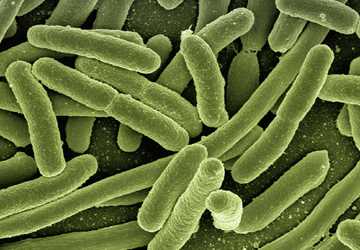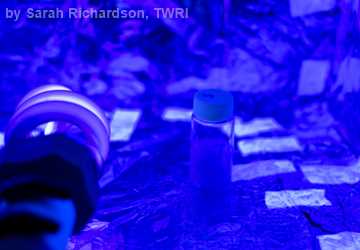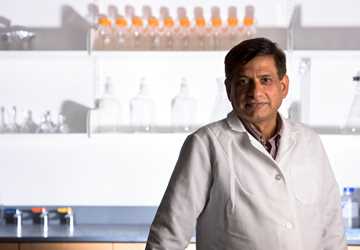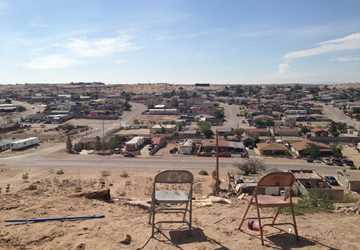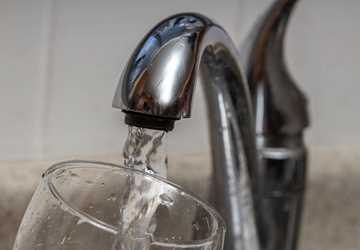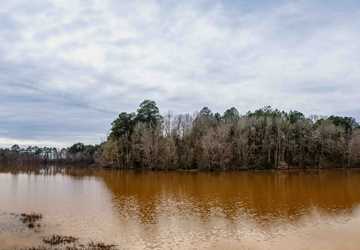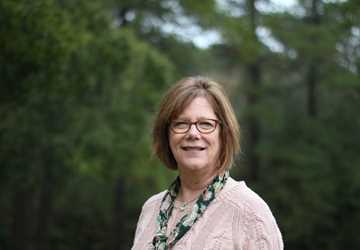Dr. Lucas Gregory grew up playing in the woods and streams of East Texas. He’d bring baby alligators home, putting them in the bathtub and gleefully showing his mother before returning them to the stream. He’d spend hours out in the woods — and sometimes, he’d get thirsty.
“I distinctly remember drinking water out of a pond, watching a cow drinking out of the other side of the pond, and she was peeing in the pond at the same time,” Gregory said. “And I was hot and thirsty, my house was two miles away, and I just didn’t care. So we both just kept drinking.”
Gregory didn’t get sick from drinking the water, but the memory stuck with him. He’s now a senior research scientist at Texas Water Resources Institute (TWRI), where he works on understanding the drivers of changing surface water quality and restoring impaired waters not unlike the pond he drank from as a child.
East Texas is one of the major geographic areas where Gregory and others from TWRI work to improve water quality. Across East Texas, 32 water bodies are listed on the 303(d) list as impaired because of bacteria levels. The 303(d) list, which is named for the relevant section of the Clean Water Act, is the list of impaired water bodies in a state.
Texas Water Resources Institute works with partners to improve water quality in East Texas, including the Attoyac Bayou watershed.
More Information
Want to get txH20 delivered right to your inbox? Click to subscribe.
According to the Clean Water Act, the pollutants in the water bodies must be identified, and the state is required to take actions to improve them, such as creating a watershed protection plan (WPP).
In recent years, Gregory and TWRI’s work has been paying off. The water quality for East Texas’ Attoyac Bayou watershed — not far from where Gregory grew up — has been improving, thanks to management strategies included in a 2014 WPP developed by the Attoyac Bayou Watershed Partnership, with assistance from TWRI, Angelina & Neches River Authority (ANRA), Stephen F. Austin State University (SFA), Castilaw Environmental Services, LLC, Texas A&M AgriLife Extension Service and Texas A&M AgriLife Research.
The Attoyac Bayou watershed makes up the northern part of the Lower Angelina River sub-basin, which is in turn part of the larger Neches River Basin. The watershed is nestled in rural pine forests, spanning an over 350,000-acre area from the 440-person town of Mt. Enterprise to Sam Rayburn Reservoir, a popular bass tournament destination. The watershed has long been home to agriculture, forestry and, more recently, oil and natural gas production. At the time the WPP was developed, approximately 13,275 people lived in the Attoyac Bayou watershed, along with an estimated 23,646 cattle and 10,155 feral hogs.
In the late 1990s, the Attoyac Bayou watershed was found to have levels of E. coli higher than Texas’ water quality standard for water bodies designated as usable for recreation. By the early 2000s, the bayou was listed on the 303(d) list as impaired because of its high E. coli levels.
The E. coli itself is not necessarily dangerous — the strain of E. coli that researchers like Gregory monitor in the Attoyac Bayou watershed is not harmful to humans. It occurs naturally in the gut system of “everything with hair, fur and feathers,” Gregory said, and then it is excreted by those animals.
But the E. coli serves as an indicator bacteria: Its presence indicates that there’s fecal waste in the water. That fecal waste can contain all sorts of nastier pathogens, such as norovirus and the parasites giardia and cryptosporidium, all of which cause a spectrum of highly contagious gastrointestinal illnesses. Knowing the concentration of E. coli in the water allows researchers to statistically estimate the risk of someone engaged in primary contact recreation, such as swimming, contracting a gastrointestinal illness.
Looking at the water, it’s hard to tell there’s a problem, said Jeremiah Poling, ANRA’s information resources manager. ANRA has been monitoring the bayou for over 20 years.
“The issues that we have in the watershed are not visible. There could be raw sewage, and you wouldn’t know from looking at the water. And it’s diluted enough that you’re not going to smell it,” Poling said. “You don’t see it until you pull it up on a lab test or until you drink some of the water and it causes gastric distress.”
To establish the concentration of E. coli and determine the water quality in a water body, researchers do routine monitoring. In the Attoyac Bayou watershed, that monitoring is done by researchers from ANRA and SFA. The monitoring team collects data about water flow, temperature, pH and amount of dissolved oxygen, and they bottle samples of water to bring back to the lab.
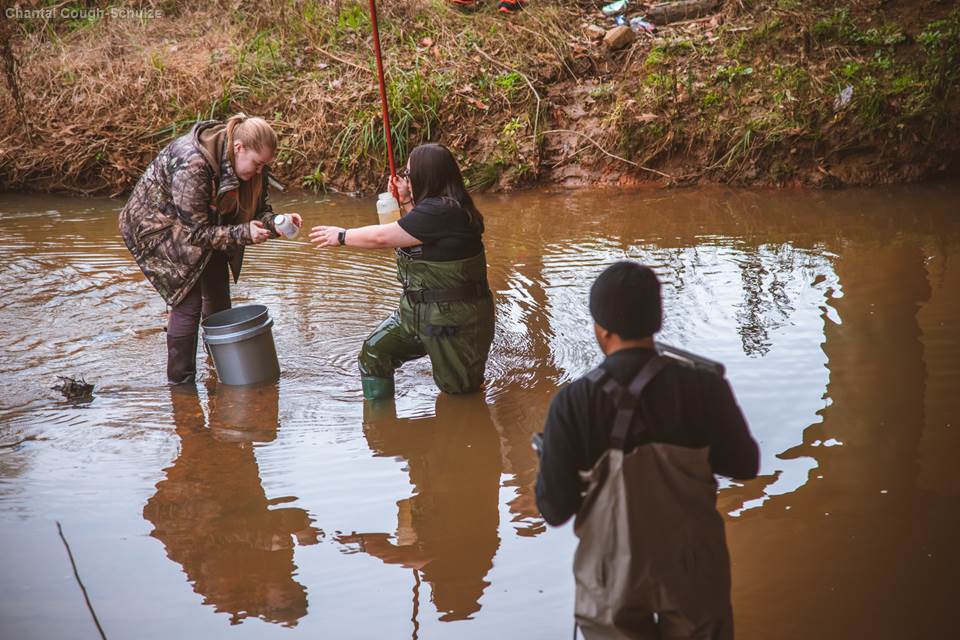
“With routine monitoring, we’re essentially establishing a baseline for the water body. We’re not trying to find pollution, but sometimes we do,” Poling said.
In the lab, researchers test for everything from chemical compounds, such as ammonia and chloride, to bacteria, such as E. coli. During the development of the WPP, they also compared some of the E. coli found to existing samples so the source of the E. coli could be identified. This comparison and identification process is called bacterial source tracking, said TWRI research assistant Anna Gitter.
“We get fecal samples in the field and identify the DNA ‘fingerprints’ of the E. coli. We collect water samples and do the same thing,” Gitter said. “Then we compare fingerprints and see what sources of E. coli are in the water bodies.”
The sources of E. coli tell a story of the area, the kinds of pollution and the impacts they might have on people living nearby. The Attoyac Bayou watershed is wooded and rural, so wildlife — both native species and nonnative species — are a major contributor. The bayou has more cattle than people; livestock logically make up a good portion of the pollution. People in the area also contribute a great deal of pollution, often via failing septic systems.
Gregory said some sources were easier to address in the Attoyac Bayou Watershed Protection Plan than others were. To address pollution from livestock, the WPP recommends developing water quality management plans for farms and ranches. These voluntary plans — with a small financial incentive — help stakeholders make property-specific improvements to their land, such as increasing livestock’s access to water other than the creeks and creating cross fencing to allow for improved rotational grazing management. Both practices decrease the amount of time livestock spend in or near impaired water bodies, resulting in less livestock waste finding its way downstream.
Though wildlife account for a large portion of the E. coli found in the bayou, barring them from the water was unrealistic.
“Wildlife are wild — you can’t just put up a fence and make the squirrels stay out. They just don’t play by the same rules,” Gregory said.
He said one wildlife pollution source that the watershed team could address — marginally at least — was feral hogs. Invasive feral hogs, of which there are an estimated 10,155 in the Attoyac Bayou watershed, wallow in and near creeks to cool themselves down, allowing their fecal waste to get into the water. With East Texas’ tree cover, feral hogs have many places to hide, making mass removal efforts difficult, said Dr. Matthew McBroom, a professor of hydrology at SFA who has worked on East Texas water issues for nearly 25 years.
We’re not trying to find pollution, but sometimes we do.
“There’s no one magic bullet for managing feral hogs,” McBroom said, but limiting food resources can help keep the population under control. In 2011, AgriLife Extension scientists found that constructing a particular kind of 28-inch high fence effectively excluded feral hogs from accessing deer feeders, which are an important source of food.
In addition, pollution from humans, Gregory said, was one of the most important sources to address.
“What is most likely to harm you as a human is something from a human,” he said. “That virus, protozoa or bacterium is adapted to the human system.
“Pollution from humans is something we caused in the first place. But it’s something that we can manage fairly easily.”
According to local stakeholders, the biggest human-caused pollution source in the Attoyac Bayou watershed is failing or nonexistent septic systems.
“When a septic system fails, there’s basically no treatment of the sewage coming out of the house. In the worst-case scenario, there might just be a pipe running out the back of the house into the creek, which is illegal,” Gregory said. “That’s a direct deposition of E. coli going right into the water.”
Several factors contribute to those septic system failures. Maintenance can be an issue; septic systems are not a “put it in the ground and leave it thing,” Gregory said. Many of the systems are 50-60 years old, so in some cases, they’ve just outlived their workable lifespan.
The older septic systems also process wastewater differently. Most older systems are conventional systems, which are distinct from newer, aerobic systems. Conventional septic systems work by pushing wastewater into a drain field and “letting microbes in the dirt deal with it,” Poling said. But that relies on the soil being permeable enough for the wastewater to percolate through — which many East Texas soils are not.
“If the soil is really dense, wastewater can’t be readily absorbed, and it never really gets treated. The untreated wastewater just bubbles up to the surface somewhere and may drain into the creek,” Poling said.
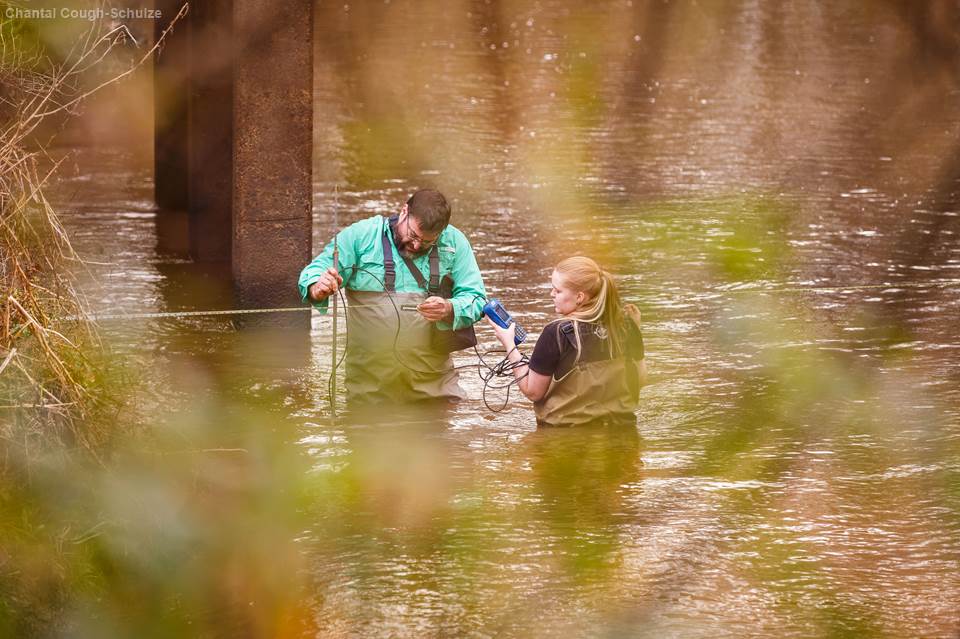
To address the septic system problems, ANRA and TWRI started a program to repair and replace failing septic systems. This often involves putting in aerobic septic systems, which work better in East Texas soils. Aerobic septic systems treat waste in a series of tanks, and the treated wastewater is then sprayed out onto vegetation and absorbed into the soil.
Though aerobic systems are better for the area, Poling said they’re also more expensive to put in. Many residents of the Attoyac Bayou watershed are low-income, so septic system repairs and replacements are funded by Texas Commission on Environmental Quality (TCEQ) through a Clean Water Act Section 319 grant from the U.S. Environmental Protection Agency and Supplemental Environmental Projects funds from TCEQ.
“You can knock on the door almost anywhere in the watershed and just say, ‘Hey, is your septic system working?’ The answer is probably going to be ‘Well, kind of.’ And if you ask if they can afford to fix it, the answer is going to be no,” Poling said. “That’s what makes these grant projects so appealing.”
The management strategies in the WPP are working: In the five years since the plan was published, the amount of pollution has begun to decrease. As of the 2016 303(d) list, E. coli concentrations in the lower portion of the Attoyac Bayou watershed dipped below the maximum allowed amount for the first time since it was added to the list. Concentrations in other parts of the bayou are also decreasing.
That decrease, Gregory said, is thanks to not only the implementation of good management strategies, but also to community involvement. Without the community’s go-ahead, good management strategies might never have gotten off the ground.
“The big difference from before the watershed protection plan is that we’ve got a stakeholder group that’s come together, talked about local issues and solutions and worked towards implementing those solutions,” Gregory said.
But early conversations with stakeholders didn’t always go smoothly. Some stakeholders were worried that decisions would be made for them without their input. At an early stakeholder meeting with a large panel of scientists, McBroom recalled a local man standing up and expressing many people’s fears.
“The man said, ‘You’re going to be making some cooking here that you don’t have to eat. You’re going to make these rules, but we’re the ones who have to live with them. Where’s your skin in the game?’”
McBroom, whose family has lived in the Attoyac Bayou watershed for roughly the past 100 years, sympathized. He was working on the WPP because he had skin in the game, he told the man. And local involvement, he said, is what would make all the difference.
“Ninety-five percent of Texas is privately owned. If you’re going to make a difference on water quality, then you’ve got to start with the private landowners,” McBroom said. “The best way to do that is to have local people at the table making local decisions. And that’s what a watershed protection plan does.”
The changes being made in the Attoyac Bayou watershed have impacts beyond just the bayou, he said, both in terms of the environment and economics.
“It’s always cheaper to prevent pollution than to clean it up after the fact, so by being proactive, we end up saving money,” McBroom said. “People own land here because they love the land. They could sell it and live in a condo in Houston, but they don’t, because they love the land. We have the opportunity to do good here in East Texas by improving water quality.”
Seeing some successes also helped inspire other stakeholders.
“After we replaced maybe 12 septic systems, word started to get out, and we would have residents from three or four houses on one street all coming forward saying, ‘This system has been in the ground for 30 years, and it’s really not working right,’” Poling said.
As of February 2020, TWRI and ANRA have repaired or replaced 49 failing septic systems in the Attoyac Bayou watershed, and they’ve secured funding for another 15 more. There’s now a waiting list for people who want their septic systems replaced, and a series of education and outreach programs about septic system maintenance are being held, Gregory said.
The work in the Attoyac Bayou watershed has provided a successful model for improving water quality and has paved the way for similar work in other East Texas watersheds, such as in La Nana Bayou and the middle Neches River and lower Neches River basins.
Even with all the changes, Gregory said there’s no way to absolutely ensure that water bodies like those in the Attoyac Bayou watershed will stay off the 303(d) list forever. So the work to improve and maintain water quality must be ongoing.
“There are too many variables, and there’s so much out there you don’t see. Just because this one part of the watershed has improved, it doesn’t mean we should stop by any means,” Gregory said. “But we’re moving in the right direction.”
Those steps in the right direction matter, Gregory said. There will always be more children playing in the woods and water just like he used to.
“You can’t keep kids out of water; they are drawn to it, almost magnetically. They’re much more likely to slip into or take a drink of nasty water,” Gregory said. “So we’ll keep working with stakeholders to improve the landscape and water quality for today and tomorrow.”
Protecting the water for future generations of stakeholders is part of what motivates McBroom as well. When he was growing up in East Texas, he used to play in a creek not far from an old, silted-in water wheel from a defunct grist mill.
“I remember looking at the water wheel and thinking, wow, people have been here for what seemed to me like forever. We’ve got a history here, and we’re a part of it,” he said. “When I have grandkids, the Attoyac will still be here. And our job is to be good stewards of it.”
Explore this Issue
Authors
As a communications specialist for Texas Water Resources Institute, Chantal Cough-Schulze worked with the institute’s communications team writing articles for and editing txH2O magazine and TWRI's news section, developing TWRI multimedia materials and editing reports and education and outreach materials. She also served as the managing editor for the Texas Water Journal.

